This step by step diy project is about 16×20 free standing pergola plans. Opting for DIY plans instead of buying a pre-made kit for a large backyard pergola empowers homeowners to personalize the design, choose their preferred materials, and enjoy the satisfaction of building a unique outdoor structure from scratch. The pergola has a 13×17 base and the roof area is 16×20. Take a look over the rest of my woodworking plans, if you want to get more building inspiration.
A large backyard pergola offers a multitude of advantages for homeowners seeking an outdoor oasis. Firstly, it provides a versatile space for relaxation and entertainment, whether you desire a shaded lounging area or an alfresco dining spot. Secondly, the pergola’s overhead structure allows for the integration of various amenities, such as hanging plants, string lights, or a retractable canopy, adding charm and functionality to the space. Lastly, the ample size of a large pergola enables the incorporation of additional features like outdoor furniture, fire pits, or even an outdoor kitchen, elevating your backyard experience to new heights. Remember that you need to read the local codes before starting the project. It is your responsibility to make adjustments and suit the legal requirements.
When buying the lumber, you should select the planks with great care, making sure they are straight and without any visible flaws (cracks, knots, twists, decay). Investing in cedar or other weather resistant lumber is a good idea, as it will pay off on the long run. Use a spirit level to plumb and align the components, before inserting the galvanized screws, otherwise the project won’t have a symmetrical look. If you have all the materials and tools required for the project, you could get the job done in about a day. See all my Premium Plans HERE.
Projects made from these plans
16×20 Pergola Plans – PDF Download

Building-a-large-pergola
Cut & Shopping Lists
A – 4 pieces of 8×8 lumber – 8 ft POSTS
B – 4 pieces of 2×12 lumber – 16 ft SUPPORT BEAMS
C – 4 pieces of 2×12 lumber – 20 ft SUPPORT BEAMS
D – 11 pieces of 2×8 lumber – 16 ft RAFTERS
E – 24 pieces of 2×4 lumber – 10 ft TOP SLATS
F – 4 piece of 8×8 lumber – 63 1/2”, 4 pieces – 52” BRACES
Tools
![]() Hammer, Tape measure, Framing square, Level
Hammer, Tape measure, Framing square, Level
![]() Miter saw, Drill machinery, Screwdriver, Sander
Miter saw, Drill machinery, Screwdriver, Sander
Time
Related
How to build a 16×20 pergola
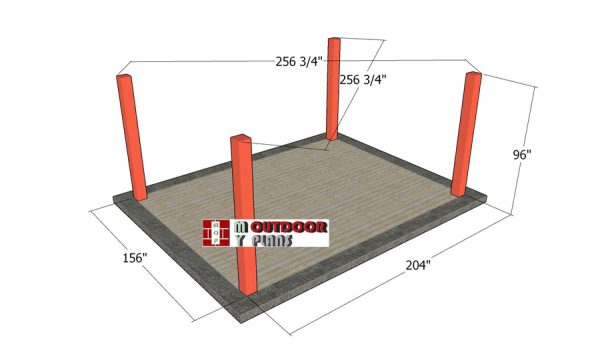
Laying-out-the-posts
The first step of the pergola project is to layout the 8×8 posts. Use batter boards and string to layout the location of the posts. Apply the 3-4-5 rule to every corner and then measure the diagonals to make sure they are perfectly equal. You need to make adjustments until you get the desired result. As you can see in the image, this pergola has a 8×10 base.
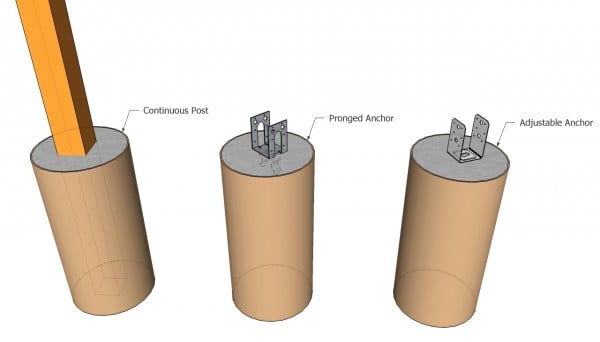
Anchoring the posts of the anchor
There are a few ways to secure the 6×6 posts into place. You can set the posts in concrete or you can use adjustable anchors and pour footings. Dig the holes 3′ deep (or under the front line) and about 14″ in diameter. Compact a layer of gravel to the bottom of the holes and then fit the tube forms. Fit the posts, align them and plumb them with a spirit level. Fill the forms with concrete, while the posts are locked into place with temporarily braces. If you use anchors, you need to align and set them into concrete. Fit the posts after the concrete dries, using lag screw.
Smart tip: Read the local building codes, so you dig the holes at the appropriate depth. For this project, I will assume you will use post anchors, so if you set the posts into concrete, make sure you add 3′ to the posts size.
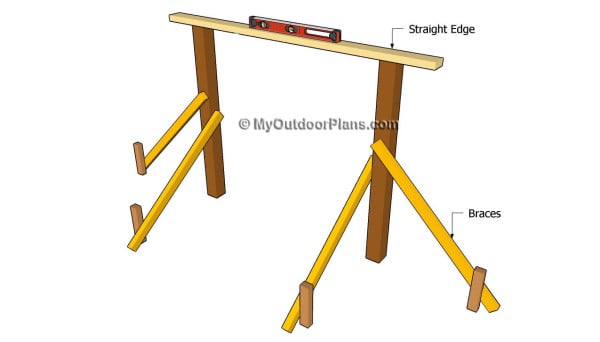
Installing the posts
After setting the posts into place, check if they are level and user a circular saw to make corrections. Notice the temporarily braces that hold the posts plumb. Leave the braces into place until you finish the assembly of the pergola. The temporarily braces will give support to the structure.
Building the beams

Support-beams for pergola
Continue the project by cutting the base beams. Use 2×12 lumber for the beams. Mark the cut lines to the boards and get the job done with a circular saw (full dimensions in the Premium Pans). You can customize the decorative ends for the rafters to suit the design of your home (Premium Plans show details on how to make the decorative cuts to the ends of the beams).
Use a circular saw for the notches inside the rafters. Make parallel cuts inside the marked areas and remove the excess with a chisel. Clean the recess with sandpaper. Use a jigsaw to make the curved cuts. Smooth the edges with sandpaper.

Fitting-the-base-support-beams
Fit the support beams to the posts, 8 1/4″ offset from the top, and use a spirit level to make sure they are perfectly horizontal. Clamp the beams to the posts and drill pilot holes. Insert 11″ carriage bolts to lock everything with attention. Use washers on both beams. Insert 2 bolts for each joint.
Notice the 18″ overhangs on both sides of the pergola.
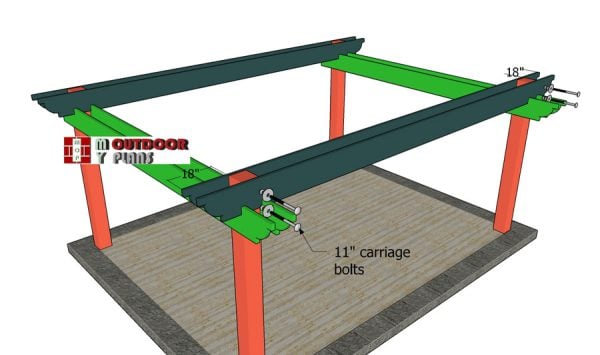
Attaching-the-support-beams
Attach the second tier of support beams, perpendicular to the other beams. Notice the 18″ overhangs to both ends of the beams. Drill pilot holes and insert 11″ carriage bolts. Use washers and nuts to lock the bolts tightly.
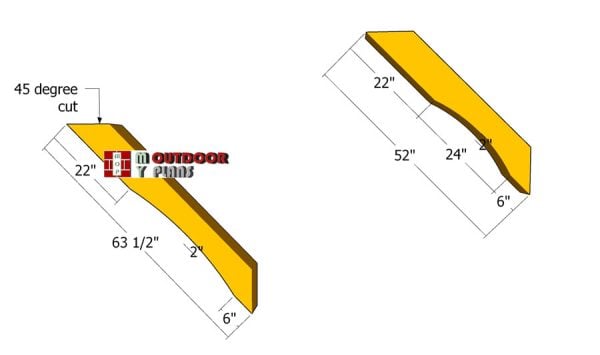
Braces
Use 8×8 lumber for the braces. Make 45 degree cuts to both ends of the braces. In addition, notice the curved cuts to the braces, that add a touch of style to the project. Mark the cut lines and get the job done with a jigsaw. Smooth the edges with sandpaper.
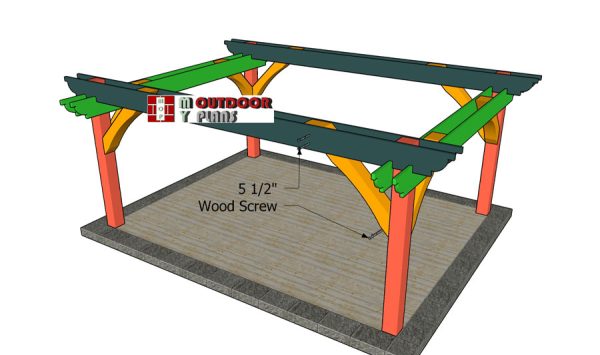
Fitting-the-braces
Attach the braces to the free standing pergola. Plumb the posts vertically and then attach the braces with 5 1/2″ screws. As you can see in the diagram, drill pilot holes and insert the screws through the braces into the posts. Also, insert the screws through the top support beams into the braces.
Fitting the rafters
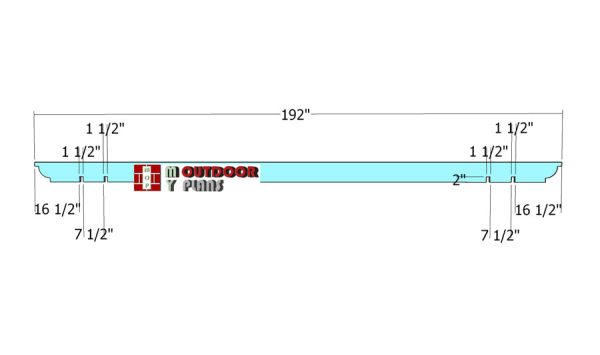
Rafters

Decorative-ends
Use 2×8 lumber for the top rafters. Make the slots to the beams using a circular saw, by performing several parallel cuts inside the marked areas. Remove the excess material and clean the recess with a chisel.
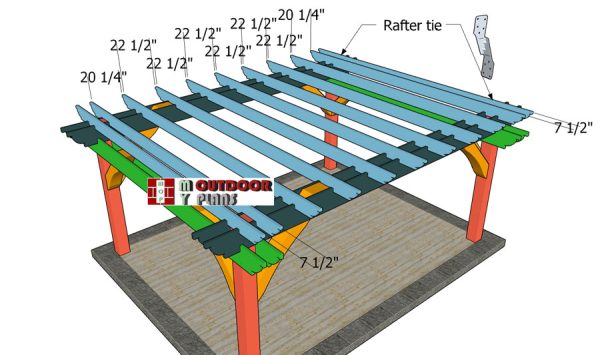
Fitting-the-rafters
Fit the 2×8 rafters to the top of the pergola frame. Place the rafters equally spaced, every 24″ on center, as shown in the diagram. Next, position the rafters on top of the support beams, aligning them with the markings.
Use a level to ensure the rafters are straight and evenly spaced, providing structural stability and aesthetic appeal to your pergola. Use rafter ties and 1 1/2″ structural screws to lock the rafters to the supports beams.
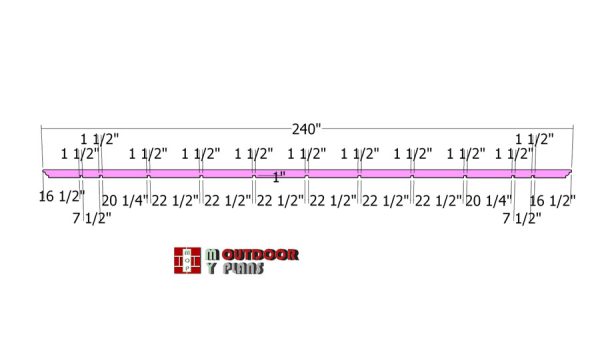
Top-slats
You need to make 1″ deep notches to the top slats, so you can install them into place tightly. In addition, you can use 2 2x4s at 10 ft instead of using a 20 ft board, which is harder to finder and more expensive.
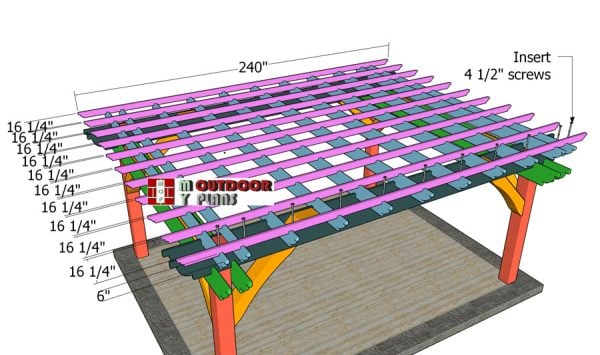
Fitting-the-top-slats
Last but not least, attach the 2×4 slats to the top of the pergola. These slats will reinforce the rigidity of the structure and they will also determine the amount of shade your pergola has. More slats and you get more shade, less slats and you get less shade. Place 16 1/4″ spacers between the slats to create even gaps.
Drill pilot holes and insert 4 1/2″ screws to lock the slats to the rafters. Make sure you secure each slat with at least 3 screws to the rafters. Alternating the screws will accomplish a more rigid structure.
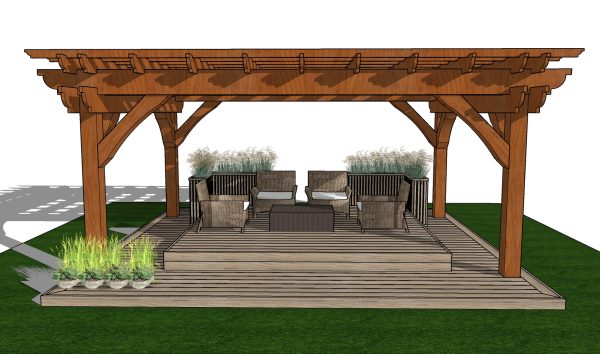
16×20 pergola plans – side view
When it comes to preserving the wood of a pergola, this involve steps to protect and extend the lifespan of the material. Firstly, applying a wood stain or paint can enhance the aesthetic appeal while providing a protective barrier against moisture and UV damage.
Secondly, consider using a waterproof sealant or varnish to seal the wood and prevent rot, warping, and insect infestation. Lastly, regular maintenance, including cleaning and reapplying protective coatings as needed, will help maintain the integrity and longevity of the wood in your pergola.
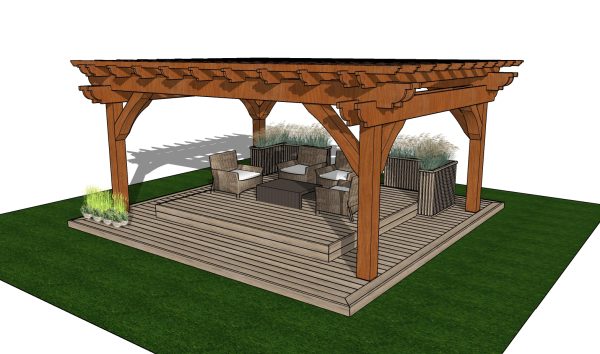
16×20 pergola plans
The finishing touches to a pergola project involve adding elements that enhance its beauty and functionality. Firstly, consider installing decorative lattice panels or trellises to provide privacy and create a charming visual appeal.
Secondly, incorporate climbing plants or vines around the pergola to add natural beauty and shade. Lastly, add outdoor lighting fixtures such as string lights, lanterns, or spotlights to create a warm and inviting ambiance for evening enjoyment.
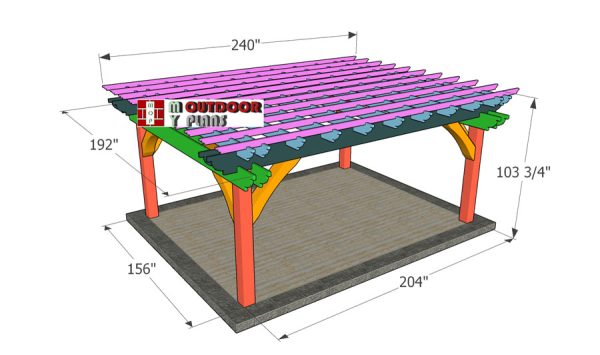
16×20-pergola-plans—dimensions
If you want to add charm and unique appeal to your garden, I recommend you to check out these plans. Generally, a minimum of two people is recommended to handle tasks such as lifting and holding the structure in place while it is being assembled and secured. However, depending on your skills, additional hands may be required to ensure efficient and safe construction.
A large pergola brings about a multitude of lifestyle improvements for homeowners. It offers a flexible outdoor area suitable for entertaining, dining, or simply unwinding amidst nature. With its sheltering capabilities, it allows for year-round enjoyment of the outdoors, regardless of weather conditions. Additionally, a large pergola enhances the overall aesthetics of the property, creating an inviting ambiance that adds value and pride to the homeowner’s living space.
Check out the rest of my pergola plans, as I have many designs and sizes you can choose from. In addition, I have over 1500 free woodworking plans on the blog, if you need more building inspiration. If you want to get Premium Plans for this project in a free-ad PDF file, with full Cut and Shopping lists included, as well as a Cut Layout Diagram (shows how to make the cuts so you get least waste) click the GET PDF PLANS button bellow.
This woodworking project was about 16×20 pergola plans. If you want to see more outdoor plans, check out the rest of our step by step projects and follow the instructions to obtain a professional result.





